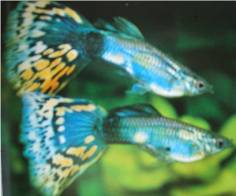Guppy
Genus name: Poecilia Reticulata
Distribution: Northern Brazil, Venezuela, Guyana, Barbados, Trinidad
Length: males up to 1.2″ (3cm), females to 2.4″ (6cm)
Water Temperature: 72-83F (22-28C)
Diet: Worms, dried food, plant matter, crustaceans, insects
Water: medium hard and slightly alkaline
Breeding: Livebearers
Community Tank (avoid mixing with fin-nippers)
The Guppy is probably the best known of all tropical aquarium fish. In the 1860’s a few living pairs were sent to the British Museum in London by Robert John Lechmere Guppy, hence the popular name which is now used in all parts of the world.
The male Guppy is very easy to distinguish from the female. The male is smaller, has longer, more colourful fins, while the female is larger and is dull by comparison. However the most obvious feature on the male is the gonopodium – a stick-like modified anal fin, instead of the normal rounded fin found on the female Guppy.
Even Guppys caught in the wild (particularly the males), show considerable variation in colours and patterns. However, since they have been introduced to aquariums, and have been subjected to breeding by aquarists, they now come in numerous colours, and are often blue or orange based. Guppys also come with a variety of fins, like round tail, spadetail, speartail, pintail, fantail, and many others.
To breed Guppys it is recommended to have 2-3 females for each male, as this helps reduce the stress on the females. Each female will produce anywhere from 20 to 100 live young every 4-6 weeks. If you want the baby Guppys to survive it is advisable to keep them in a nursery tank, as both the parents and any other fish will eat them. Alternatively have dense plant life which the baby Guppys can hide in, and some might make it to maturity.

